dashboard HONDA ACCORD 2016 9.G Quick Guide
[x] Cancel search | Manufacturer: HONDA, Model Year: 2016, Model line: ACCORD, Model: HONDA ACCORD 2016 9.GPages: 83, PDF Size: 7.35 MB
Page 3 of 83
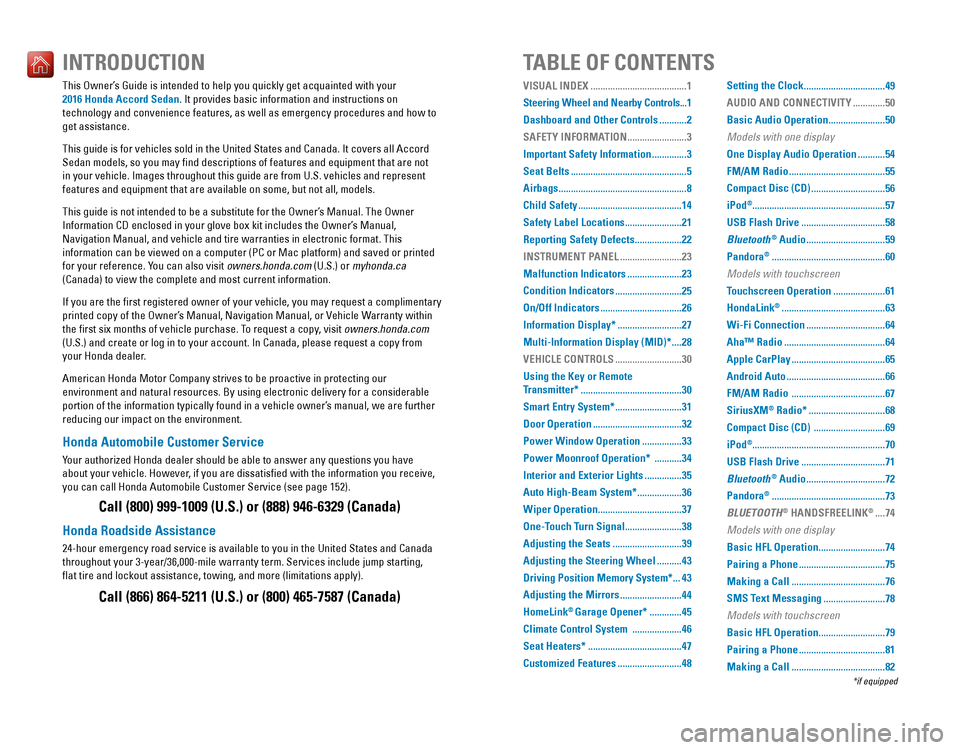
INTRODUCTIONTABLE OF CONTENTS
This‚ÄāOwner‚Äôs‚ÄāGuide‚Äāis‚Äāintended‚Äāto‚Äāhelp‚Äāyou‚Äāquickly‚Äāget‚Äāacquainted‚Äāwith‚Äāyour
2016 Honda Accord Sedan
.‚ÄāIt‚Äāprovides‚Äābasic‚Äāinformation‚Äāand‚Äāinstructions‚Äāon‚Äā
technology and convenience features, as well as emergency procedures and\
how to
get assistance.
This‚Äāguide‚Äāis‚Äāfor‚Äāvehicles‚Äāsold‚Äāin‚Äāthe‚ÄāUnited‚ÄāStates‚Äāand‚ÄāCanada.‚ÄāIt‚Äācovers‚Äāall‚ÄāAccord‚Äā
Sedan‚Äāmodels,‚Äāso‚Äāyou‚Äāmay‚Äāfind‚Äādescriptions‚Äāof‚Äāfeatures‚Äāand‚Äāequipment‚Äāthat‚Äāare‚Äānot‚Äā
in‚Äāyour‚Äāvehicle.‚ÄāImages‚Äāthroughout‚Äāthis‚Äāguide‚Äāare‚Äāfrom‚ÄāU.S.‚Äāvehicles‚Äāand‚Äārepresent‚Äā
features‚Äāand‚Äāequipment‚Äāthat‚Äāare‚Äāavailable‚Äāon‚Äāsome,‚Äābut‚Äānot‚Äāall,‚Äāmodels.
This‚Äāguide‚Äāis‚Äānot‚Äāintended‚Äāto‚Äābe‚Äāa‚Äāsubstitute‚Äāfor‚Äāthe‚ÄāOwner‚Äôs‚ÄāManual.‚ÄāThe‚ÄāOwner‚Äā
Information‚ÄāCD‚Äāenclosed‚Äāin‚Äāyour‚Äāglove‚Äābox‚Äākit‚Äāincludes‚Äāthe‚ÄāOwner‚Äôs‚ÄāManual,‚Äā
Navigation Manual, and vehicle and tire warranties in electronic format.\
This
information‚Äācan‚Äābe‚Äāviewed‚Äāon‚Äāa‚Äācomputer‚Äā(PC‚Äāor‚ÄāMac‚Äāplatform)‚Äāand‚Äāsaved‚Äāor‚Äāprinted‚Äā
for your reference. You can also visit owners.honda.com (U.S.) or myhonda.ca
(Canada) to view the complete and most current information.
If‚Äāyou‚Äāare‚Äāthe‚Äāfirst‚Äāregistered‚Äāowner‚Äāof‚Äāyour‚Äāvehicle,‚Äāyou‚Äāmay‚Äārequest‚Äāa‚Äācomplimentary‚Äā
printed‚Äācopy‚Äāof‚Äāthe‚ÄāOwner‚Äôs‚ÄāManual,‚ÄāNavigation‚ÄāManual,‚Äāor‚ÄāVehicle‚ÄāWarranty‚Äāwithin‚Äā
the‚Äāfirst‚Äāsix‚Äāmonths‚Äāof‚Äāvehicle‚Äāpurchase.‚ÄāTo‚Äārequest‚Äāa‚Äācopy,‚Äāvisit‚Äāowners.honda.com
(U.S.)‚Äāand‚Äācreate‚Äāor‚Äālog‚Äāin‚Äāto‚Äāyour‚Äāaccount.‚ÄāIn‚ÄāCanada,‚Äāplease‚Äārequest‚Äāa‚Äācopy‚Äāfrom‚Äā
your Honda dealer.
American‚ÄāHonda‚ÄāMotor‚ÄāCompany‚Äāstrives‚Äāto‚Äābe‚Äāproactive‚Äāin‚Äāprotecting‚Äāour‚Äā
environment‚Äāand‚Äānatural‚Äāresources.‚ÄāBy‚Äāusing‚Äāelectronic‚Äādelivery‚Äāfor‚Äāa‚Äāconsiderable‚Äā
portion of the information typically found in a vehicle owner’s manual, we are further
reducing our impact on the environment.
Honda Automobile Customer Service
Your‚Äāauthorized‚ÄāHonda‚Äādealer‚Äāshould‚Äābe‚Äāable‚Äāto‚Äāanswer‚Äāany‚Äāquestions‚Äāyou‚Äāhave‚Äā
about‚Äāyour‚Äāvehicle.‚ÄāHowever,‚Äāif‚Äāyou‚Äāare‚Äādissatisfied‚Äāwith‚Äāthe‚Äāinformation‚Äāyou‚Äāreceive,‚Äā
you‚Äācan‚Äācall‚ÄāHonda‚ÄāAutomobile‚ÄāCustomer‚ÄāService‚Äā(see‚Äāpage‚Äā152).
Call (800) 999-1009 (U.S.) or (888) 946-6329 (Canada)
Honda Roadside Assistance
24-hour‚Äāemergency‚Äāroad‚Äāservice‚Äāis‚Äāavailable‚Äāto‚Äāyou‚Äāin‚Äāthe‚ÄāUnited‚ÄāStates‚Äāand‚ÄāCanada‚Äā
throughout‚Äāyour‚Äā3-year/36,000-mile‚Äāwarranty‚Äāterm.‚ÄāServices‚Äāinclude‚Äājump‚Äāstarting,‚Äā
flat tire and lockout assistance, towing, and more (limitations apply\
).
Call (866) 864-5211 (U.S.) or (800) 465-7587 (Canada)
*if‚Äāequipped
VISUAL INDEX .......................................1
Steering Wheel and Nearby Controls ...1
Dashboard and Other Controls
...........2
SAFETY INFORMATION
........................3
Important Safety Information
..............3
Seat Belts
...............................................5
Airbags
....................................................8
Child Safety
..........................................14
Safety Label Locations
.......................21
Reporting Safety Defects
...................22
INSTRUMENT PANEL
.........................23
Malfunction Indicators
......................23
Condition Indicators
...........................25
On/Off Indicators
.................................26
Information Display*
..........................27
Multi-Information Display (MID)*
....28
VEHICLE CONTROLS
...........................30
Using the Key or Remote
Transmitter*
.........................................30
Smart Entry System*
...........................31
Door Operation
....................................32
Power Window Operation
................33
Power Moonroof Operation*
...........34
Interior and Exterior Lights
...............35
Auto High-Beam System*
..................36
Wiper Operation
..................................37
One-Touch Turn Signal
.......................38
Adjusting the Seats
............................39
Adjusting the Steering Wheel
..........43
Driving Position Memory System*
...43
Adjusting the Mirrors
.........................44
HomeLink
¬ģ Garage Opener* .............45
Climate Control System
....................46
Seat Heaters*
......................................47
Customized Features
..........................48 Setting the Clock
.................................49
AUDIO AND CONNECTIVITY
.............50
Basic Audio Operation
.......................50
Models‚Äāwith‚Äāone‚Äādisplay
One Display Audio Operation ...........54
FM/AM Radio
.......................................55
Compact Disc (CD)
..............................56
iPod
¬ģ...................................................... 57
USB Flash Drive
..................................58
Bluetooth
¬ģ Audio ................................59
Pandora
¬ģ ..............................................60
Models‚Äāwith‚Äātouchscreen
Touchscreen Operation .....................61
HondaLink
¬ģ ..........................................63
Wi-Fi Connection
................................64
Aha‚ĄĘ Radio
.........................................64
Apple CarPlay
......................................65
Android Auto
........................................66
FM/AM Radio
......................................67
SiriusXM
¬ģ Radio* ...............................68
Compact Disc (CD)
.............................69
iPod
¬ģ...................................................... 70
USB Flash Drive
..................................71
Bluetooth
¬ģ Audio ................................72
Pandora
¬ģ ..............................................73
BLUETOOTH
¬ģ HANDSFREELINK¬ģ ....74
Models‚Äāwith‚Äāone‚Äādisplay
Basic HFL Operation ...........................74
Pairing a Phone
...................................75
Making a Call
......................................76
SMS Text Messaging
.........................78
Models‚Äāwith‚Äātouchscreen
Basic HFL Operation ...........................79
Pairing a Phone
...................................81
Making a Call
......................................82
Page 5 of 83
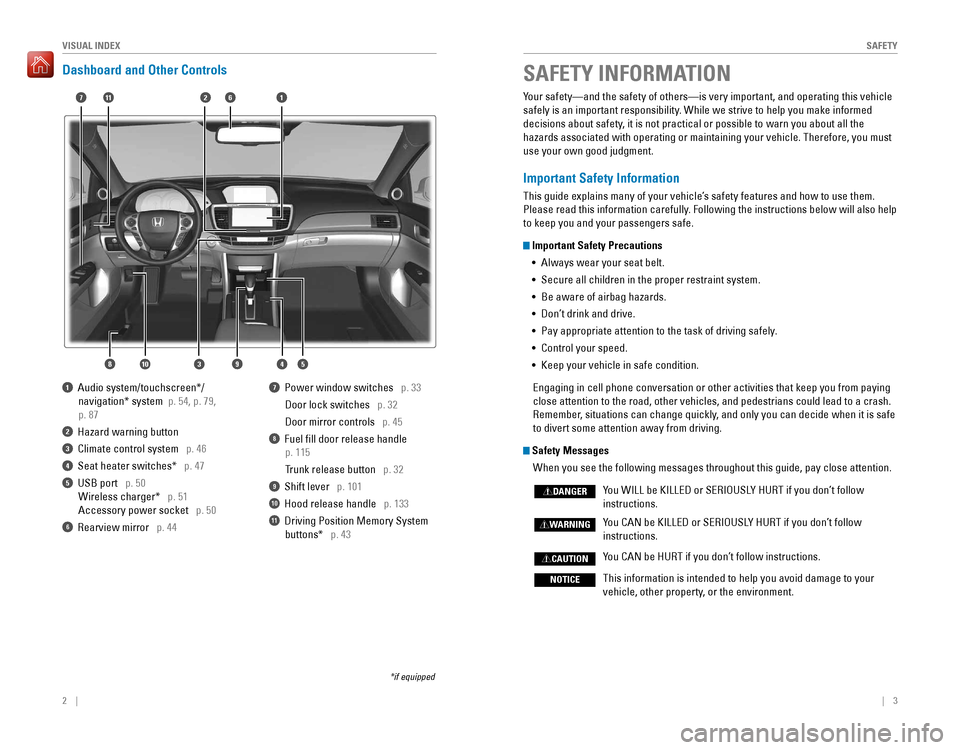
2 || 3
SAFETYVISUAL INDEX
Dashboard and Other Controls
1‚Äā‚ÄāAudio‚Äāsystem/touchscreen*/‚Äā ‚Äā
‚Äānavigation*‚Äāsystem‚Äā‚Äāp. 54, p. 79,
p. 87
2‚Äā‚ÄāHazard‚Äāwarning‚Äābutton
3 Climate control system p. 46
4‚Äā‚ÄāSeat‚Äāheater‚Äāswitches*‚Äā‚Äā‚Äāp. 47
5 USB port p. 50
Wireless‚Äācharger*‚Äā‚Äā‚Äāp. 51
Accessory power socket p. 50
6 rearview mirror p. 44
7 Power window switches p. 33
Door lock switches p. 32
Door mirror controls p. 45
8 Fuel fill door release handle
p. 115
Trunk‚Äārelease‚Äābutton‚Äā‚Äā‚Äāp. 32
9 Shift lever p. 101
10 Hood release handle p. 133
11 Driving Position Memory System
‚Äābuttons*‚Äā‚Äā‚Äāp. 43
*if‚Äāequipped
SAFETY INFORMATION
2
4
71
8
6
3
Your safety‚ÄĒand the safety of others‚ÄĒis very important, and operati\
ng this vehicle
safely‚Äāis‚Äāan‚Äāimportant‚Äāresponsibility.‚ÄāWhile‚Äāwe‚Äāstrive‚Äāto‚Äāhelp‚Äāyou‚Äāmake‚Äāinformed‚Äā
decisions‚Äāabout‚Äāsafety,‚Äāit‚Äāis‚Äānot‚Äāpractical‚Äāor‚Äāpossible‚Äāto‚Äāwarn‚Äāyou‚Äāabout‚Äāall‚Äāthe‚Äā
hazards‚Äāassociated‚Äāwith‚Äāoperating‚Äāor‚Äāmaintaining‚Äāyour‚Äāvehicle.‚ÄāTherefore,‚Äāyou‚Äāmust‚Äā
use your own good judgment.
Important Safety Information
This guide explains many of your vehicle’s safety features and how to use them.
Please‚Äāread‚Äāthis‚Äāinformation‚Äācarefully.‚ÄāFollowing‚Äāthe‚Äāinstructions‚Äābelow‚Äāwill‚Äāalso‚Äāhelp‚Äā
to keep you and your passengers safe.
Important Safety Precautions
‚ÄĘ‚Äā
Always‚Äāwear‚Äāyour‚Äāseat‚Äābelt.
‚ÄĘ‚Äā Secure all children in the proper restraint system.
‚ÄĘ‚Äā
Be‚Äāaware‚Äāof‚Äāairbag‚Äāhazards.
‚ÄĘ‚Äā Don‚Äôt drink and drive.
‚ÄĘ‚Äā Pay appropriate attention to the task of driving safely.
‚ÄĘ‚Äā Control your speed.
‚ÄĘ‚Äā Keep your vehicle in safe condition.
engaging in cell phone conversation or other activities that keep you fro\
m paying
close attention to the road, other vehicles, and pedestrians could lead \
to a crash.
Remember,‚Äāsituations‚Äācan‚Äāchange‚Äāquickly,‚Äāand‚Äāonly‚Äāyou‚Äācan‚Äādecide‚Äāwhen‚Äāit‚Äāis‚Äāsafe‚Äā
to divert some attention away from driving.
Safety Messages
When‚Äāyou‚Äāsee‚Äāthe‚Äāfollowing‚Äāmessages‚Äāthroughout‚Äāthis‚Äāguide,‚Äāpay‚Äāclose‚Äāattention.
You‚ÄāWILL‚Äābe‚ÄāKILLED‚Äāor‚ÄāSERIOUSLY‚ÄāHURT‚Äāif‚Äāyou‚Äādon‚Äôt‚Äāfollow‚Äā‚Äā‚Äā‚Äā
instructions.
You‚ÄāCAN‚Äābe‚ÄāKILLED‚Äāor‚ÄāSERIOUSLY‚ÄāHURT‚Äāif‚Äāyou‚Äādon‚Äôt‚Äāfollow‚Äā‚Äā ‚Äā
instructions.
You‚ÄāCAN‚Äābe‚ÄāHURT‚Äāif‚Äāyou‚Äādon‚Äôt‚Äāfollow‚Äāinstructions.
This information is intended to help you avoid damage to your
vehicle, other property, or the environment.
DANGER
WARNING
CAUTION
NOTICE
5910
11
Page 8 of 83
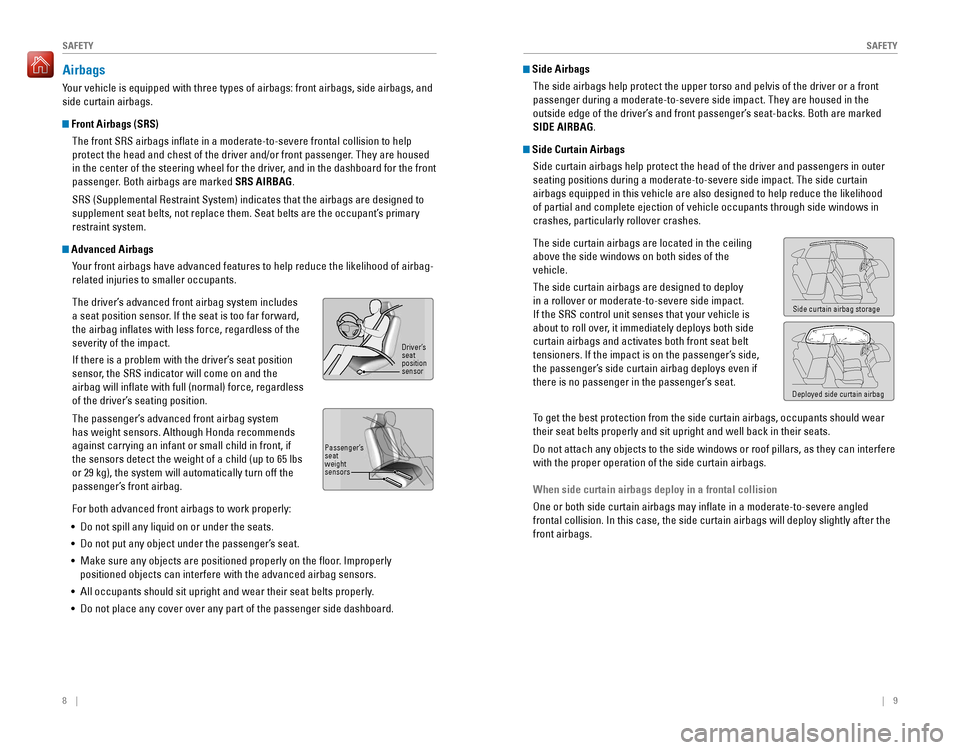
8 || 9
SAFETYSAFETY
Airbags
Your‚Äāvehicle‚Äāis‚Äāequipped‚Äāwith‚Äāthree‚Äātypes‚Äāof‚Äāairbags:‚Äāfront‚Äāairbags,‚Äāside‚Äāairbags,‚Äāand‚Äā
side‚Äācurtain‚Äāairbags.
Front Airbags (SRS)
The‚Äāfront‚ÄāSRS‚Äāairbags‚Äāinflate‚Äāin‚Äāa‚Äāmoderate-to-severe‚Äāfrontal‚Äācollision‚Äāto‚Äāhelp‚Äā
protect‚Äāthe‚Äāhead‚Äāand‚Äāchest‚Äāof‚Äāthe‚Äādriver‚Äāand/or‚Äāfront‚Äāpassenger.‚ÄāThey‚Äāare‚Äāhoused‚Äā
in‚Äāthe‚Äācenter‚Äāof‚Äāthe‚Äāsteering‚Äāwheel‚Äāfor‚Äāthe‚Äādriver,‚Äāand‚Äāin‚Äāthe‚Äādashboard‚Äāfor‚Äāthe‚Äāfront‚Äā
passenger.‚ÄāBoth‚Äāairbags‚Äāare‚Äāmarked‚ÄāSRS AIRBAG.
SRS‚Äā(Supplemental‚ÄāRestraint‚ÄāSystem)‚Äāindicates‚Äāthat‚Äāthe‚Äāairbags‚Äāare‚Äādesigned‚Äāto‚Äā
supplement‚Äāseat‚Äābelts,‚Äānot‚Äāreplace‚Äāthem.‚ÄāSeat‚Äābelts‚Äāare‚Äāthe‚Äāoccupant‚Äôs‚Äāprimary‚Äā
restraint system.
Advanced Airbags
Your‚Äāfront‚Äāairbags‚Äāhave‚Äāadvanced‚Äāfeatures‚Äāto‚Äāhelp‚Äāreduce‚Äāthe‚Äālikelihood‚Äāof‚Äāairbag-
related injuries to smaller occupants.
The‚Äādriver‚Äôs‚Äāadvanced‚Äāfront‚Äāairbag‚Äāsystem‚Äāincludes‚Äā
a‚Äāseat‚Äāposition‚Äāsensor.‚ÄāIf‚Äāthe‚Äāseat‚Äāis‚Äātoo‚Äāfar‚Äāforward,‚Äā
the‚Äāairbag‚Äāinflates‚Äāwith‚Äāless‚Äāforce,‚Äāregardless‚Äāof‚Äāthe‚Äā
severity of the impact.
If‚Äāthere‚Äāis‚Äāa‚Äāproblem‚Äāwith‚Äāthe‚Äādriver‚Äôs‚Äāseat‚Äāposition‚Äā
sensor, the SrS indicator will come on and the
airbag‚Äāwill‚Äāinflate‚Äāwith‚Äāfull‚Äā(normal)‚Äāforce,‚Äāregardless‚Äā
of the driver’s seating position.
The‚Äāpassenger‚Äôs‚Äāadvanced‚Äāfront‚Äāairbag‚Äāsystem‚Äā
has weight sensors. Although Honda recommends
against carrying an infant or small child in front, if
the‚Äāsensors‚Äādetect‚Äāthe‚Äāweight‚Äāof‚Äāa‚Äāchild‚Äā(up‚Äāto‚Äā65‚Äālbs‚Äā
or 29 kg), the system will automatically turn off the
passenger‚Äôs‚Äāfront‚Äāairbag.
For‚Äāboth‚Äāadvanced‚Äāfront‚Äāairbags‚Äāto‚Äāwork‚Äāproperly:‚Äā
‚ÄĘ‚ÄāDo‚Äānot‚Äāspill‚Äāany‚Äāliquid‚Äāon‚Äāor‚Äāunder‚Äāthe‚Äāseats.
‚ÄĘ‚ÄāDo‚Äānot‚Äāput‚Äāany‚Äāobject‚Äāunder‚Äāthe‚Äāpassenger‚Äôs‚Äāseat.
‚ÄĘ‚ÄāMake‚Äāsure‚Äāany‚Äāobjects‚Äāare‚Äāpositioned‚Äāproperly‚Äāon‚Äāthe‚Äāfloor.‚ÄāImproperly‚Äā
positioned‚Äāobjects‚Äācan‚Äāinterfere‚Äāwith‚Äāthe‚Äāadvanced‚Äāairbag‚Äāsensors.
‚ÄĘ‚ÄāAll‚Äāoccupants‚Äāshould‚Äāsit‚Äāupright‚Äāand‚Äāwear‚Äātheir‚Äāseat‚Äābelts‚Äāproperly.
‚ÄĘ‚ÄāDo‚Äānot‚Äāplace‚Äāany‚Äācover‚Äāover‚Äāany‚Äāpart‚Äāof‚Äāthe‚Äāpassenger‚Äāside‚Äādashboard.
Side Airbags
The‚Äāside‚Äāairbags‚Äāhelp‚Äāprotect‚Äāthe‚Äāupper‚Äātorso‚Äāand‚Äāpelvis‚Äāof‚Äāthe‚Äādriver‚Äāor‚Äāa‚Äāfront‚Äā
passenger during a moderate-to-severe side impact. They are housed in th\
e
outside‚Äāedge‚Äāof‚Äāthe‚Äādriver‚Äôs‚Äāand‚Äāfront‚Äāpassenger‚Äôs‚Äāseat-backs.‚ÄāBoth‚Äāare‚Äāmarked‚Äā
SIDE AIRBAG.
Side Curtain Airbags
Side‚Äācurtain‚Äāairbags‚Äāhelp‚Äāprotect‚Äāthe‚Äāhead‚Äāof‚Äāthe‚Äādriver‚Äāand‚Äāpassengers‚Äāin‚Äāouter‚Äā
seating positions during a moderate-to-severe side impact. The side curt\
ain
airbags‚Äāequipped‚Äāin‚Äāthis‚Äāvehicle‚Äāare‚Äāalso‚Äādesigned‚Äāto‚Äāhelp‚Äāreduce‚Äāthe‚Äālikelihood‚Äā
of partial and complete ejection of vehicle occupants through side windo\
ws in
crashes, particularly rollover crashes.
The‚Äāside‚Äācurtain‚Äāairbags‚Äāare‚Äālocated‚Äāin‚Äāthe‚Äāceiling‚Äā
above‚Äāthe‚Äāside‚Äāwindows‚Äāon‚Äāboth‚Äāsides‚Äāof‚Äāthe‚Äā
vehicle.
The‚Äāside‚Äācurtain‚Äāairbags‚Äāare‚Äādesigned‚Äāto‚Äādeploy‚Äā
in a rollover or moderate-to-severe side impact.
If‚Äāthe‚ÄāSRS‚Äācontrol‚Äāunit‚Äāsenses‚Äāthat‚Äāyour‚Äāvehicle‚Äāis‚Äā
about‚Äāto‚Äāroll‚Äāover,‚Äāit‚Äāimmediately‚Äādeploys‚Äāboth‚Äāside‚Äā
curtain‚Äāairbags‚Äāand‚Äāactivates‚Äāboth‚Äāfront‚Äāseat‚Äābelt‚Äā
tensioners.‚ÄāIf‚Äāthe‚Äāimpact‚Äāis‚Äāon‚Äāthe‚Äāpassenger‚Äôs‚Äāside,‚Äā
the‚Äāpassenger‚Äôs‚Äāside‚Äācurtain‚Äāairbag‚Äādeploys‚Äāeven‚Äāif‚Äā
there is no passenger in the passenger’s seat.
To‚Äāget‚Äāthe‚Äābest‚Äāprotection‚Äāfrom‚Äāthe‚Äāside‚Äācurtain‚Äāairbags,‚Äāoccupants‚Äāshould‚Äāwear‚Äā
their‚Äāseat‚Äābelts‚Äāproperly‚Äāand‚Äāsit‚Äāupright‚Äāand‚Äāwell‚Äāback‚Äāin‚Äātheir‚Äāseats.
Do‚Äānot‚Äāattach‚Äāany‚Äāobjects‚Äāto‚Äāthe‚Äāside‚Äāwindows‚Äāor‚Äāroof‚Äāpillars,‚Äāas‚Äāthey‚Äācan‚Äāinterfere‚Äā
with‚Äāthe‚Äāproper‚Äāoperation‚Äāof‚Äāthe‚Äāside‚Äācurtain‚Äāairbags.
When side curtain airbags deploy in a frontal collision
One‚Äāor‚Äāboth‚Äāside‚Äācurtain‚Äāairbags‚Äāmay‚Äāinflate‚Äāin‚Äāa‚Äāmoderate-to-severe‚Äāangled‚Äā
frontal‚Äācollision.‚ÄāIn‚Äāthis‚Äācase,‚Äāthe‚Äāside‚Äācurtain‚Äāairbags‚Äāwill‚Äādeploy‚Äāslightly‚Äāafter‚Äāthe‚Äā
front‚Äāairbags.
Driver’sseat
position
sensor
Passenger’s
seat
weight
sensors
Side‚Äācurtain‚Äāairbag‚Äāstorage
Deployed‚Äāside‚Äācurtain‚Äāairbag
Page 9 of 83
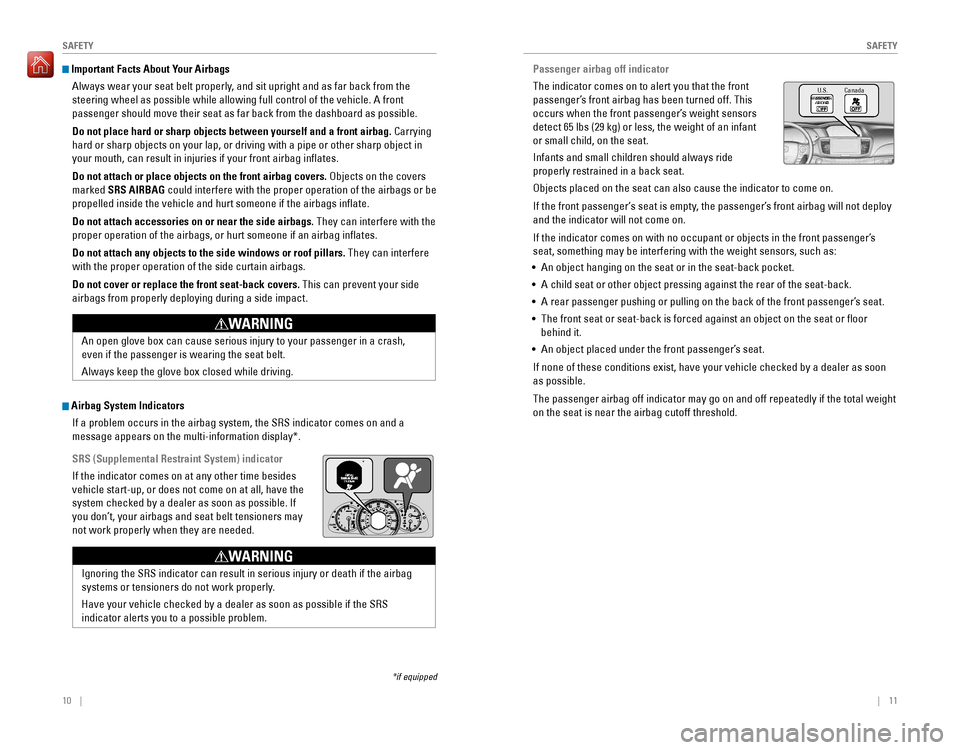
10 || 11
SAFETYSAFETY
Important Facts About Your Airbags
Always‚Äāwear‚Äāyour‚Äāseat‚Äābelt‚Äāproperly,‚Äāand‚Äāsit‚Äāupright‚Äāand‚Äāas‚Äāfar‚Äāback‚Äāfrom‚Äāthe‚Äā
steering‚Äāwheel‚Äāas‚Äāpossible‚Äāwhile‚Äāallowing‚Äāfull‚Äācontrol‚Äāof‚Äāthe‚Äāvehicle.‚ÄāA‚Äāfront‚Äā
passenger‚Äāshould‚Äāmove‚Äātheir‚Äāseat‚Äāas‚Äāfar‚Äāback‚Äāfrom‚Äāthe‚Äādashboard‚Äāas‚Äāpossible.‚Äā
Do not place hard or sharp objects between yourself and a front airbag. Carrying
hard‚Äāor‚Äāsharp‚Äāobjects‚Äāon‚Äāyour‚Äālap,‚Äāor‚Äādriving‚Äāwith‚Äāa‚Äāpipe‚Äāor‚Äāother‚Äāsharp‚Äāobject‚Äāin‚Äā
your‚Äāmouth,‚Äācan‚Äāresult‚Äāin‚Äāinjuries‚Äāif‚Äāyour‚Äāfront‚Äāairbag‚Äāinflates.
Do not attach or place objects on the front airbag covers.‚ÄāObjects‚Äāon‚Äāthe‚Äācovers‚Äā
marked SRS AIRBAG‚Äācould‚Äāinterfere‚Äāwith‚Äāthe‚Äāproper‚Äāoperation‚Äāof‚Äāthe‚Äāairbags‚Äāor‚Äābe‚Äā
propelled‚Äāinside‚Äāthe‚Äāvehicle‚Äāand‚Äāhurt‚Äāsomeone‚Äāif‚Äāthe‚Äāairbags‚Äāinflate.
Do not attach accessories on or near the side airbags. They can interfere with the
proper‚Äāoperation‚Äāof‚Äāthe‚Äāairbags,‚Äāor‚Äāhurt‚Äāsomeone‚Äāif‚Äāan‚Äāairbag‚Äāinflates.
Do not attach any objects to the side windows or roof pillars. They can interfere
with‚Äāthe‚Äāproper‚Äāoperation‚Äāof‚Äāthe‚Äāside‚Äācurtain‚Äāairbags.
Do not cover or replace the front seat-back covers. This can prevent your side
airbags‚Äāfrom‚Äāproperly‚Äādeploying‚Äāduring‚Äāa‚Äāside‚Äāimpact.
Airbag System Indicators
If‚Äāa‚Äāproblem‚Äāoccurs‚Äāin‚Äāthe‚Äāairbag‚Äāsystem,‚Äāthe‚ÄāSRS‚Äāindicator‚Äācomes‚Äāon‚Äāand‚Äāa‚Äā
message‚Äāappears‚Äāon‚Äāthe‚Äāmulti-information‚Äādisplay*.
SRS (Supplemental Restraint System) indicator
If‚Äāthe‚Äāindicator‚Äācomes‚Äāon‚Äāat‚Äāany‚Äāother‚Äātime‚Äābesides‚Äā
vehicle start-up, or does not come on at all, have the
system‚Äāchecked‚Äāby‚Äāa‚Äādealer‚Äāas‚Äāsoon‚Äāas‚Äāpossible.‚ÄāIf‚Äā
you‚Äādon‚Äôt,‚Äāyour‚Äāairbags‚Äāand‚Äāseat‚Äābelt‚Äātensioners‚Äāmay‚Äā
not work properly when they are needed.Passenger airbag off indicator
The indicator comes on to alert you that the front
passenger‚Äôs‚Äāfront‚Äāairbag‚Äāhas‚Äābeen‚Äāturned‚Äāoff.‚ÄāThis‚Äā
occurs when the front passenger’s weight sensors
detect‚Äā65‚Äālbs‚Äā(29‚Äākg)‚Äāor‚Äāless,‚Äāthe‚Äāweight‚Äāof‚Äāan‚Äāinfant‚Äā
or small child, on the seat.
Infants‚Äāand‚Äāsmall‚Äāchildren‚Äāshould‚Äāalways‚Äāride‚Äā
properly‚Äārestrained‚Äāin‚Äāa‚Äāback‚Äāseat.
Objects‚Äāplaced‚Äāon‚Äāthe‚Äāseat‚Äācan‚Äāalso‚Äācause‚Äāthe‚Äāindicator‚Äāto‚Äācome‚Äāon.
If‚Äāthe‚Äāfront‚Äāpassenger‚Äės‚Äāseat‚Äāis‚Äāempty,‚Äāthe‚Äāpassenger‚Äôs‚Äāfront‚Äāairbag‚Äāwill‚Äānot‚Äādeploy‚Äā
and the indicator will not come on.
If‚Äāthe‚Äāindicator‚Äācomes‚Äāon‚Äāwith‚Äāno‚Äāoccupant‚Äāor‚Äāobjects‚Äāin‚Äāthe‚Äāfront‚Äāpassenger‚Äôs‚Äā
seat,‚Äāsomething‚Äāmay‚Äābe‚Äāinterfering‚Äāwith‚Äāthe‚Äāweight‚Äāsensors,‚Äāsuch‚Äāas:‚Äā
‚ÄĘ‚ÄāAn‚Äāobject‚Äāhanging‚Äāon‚Äāthe‚Äāseat‚Äāor‚Äāin‚Äāthe‚Äāseat-back‚Äāpocket.
‚ÄĘ‚ÄāA‚Äāchild‚Äāseat‚Äāor‚Äāother‚Äāobject‚Äāpressing‚Äāagainst‚Äāthe‚Äārear‚Äāof‚Äāthe‚Äāseat-back.
‚ÄĘ‚ÄāA‚Äārear‚Äāpassenger‚Äāpushing‚Äāor‚Äāpulling‚Äāon‚Äāthe‚Äāback‚Äāof‚Äāthe‚Äāfront‚Äāpassenger‚Äôs‚Äāseat.
‚ÄĘ‚ÄāThe‚Äāfront‚Äāseat‚Äāor‚Äāseat-back‚Äāis‚Äāforced‚Äāagainst‚Äāan‚Äāobject‚Äāon‚Äāthe‚Äāseat‚Äāor‚Äāfloor‚Äā
behind‚Äāit.
‚ÄĘ‚ÄāAn‚Äāobject‚Äāplaced‚Äāunder‚Äāthe‚Äāfront‚Äāpassenger‚Äôs‚Äāseat.
If‚Äānone‚Äāof‚Äāthese‚Äāconditions‚Äāexist,‚Äāhave‚Äāyour‚Äāvehicle‚Äāchecked‚Äāby‚Äāa‚Äādealer‚Äāas‚Äāsoon‚Äā
as‚Äāpossible.
The‚Äāpassenger‚Äāairbag‚Äāoff‚Äāindicator‚Äāmay‚Äāgo‚Äāon‚Äāand‚Äāoff‚Äārepeatedly‚Äāif‚Äāthe‚Äātotal‚Äāweight‚Äā
on‚Äāthe‚Äāseat‚Äāis‚Äānear‚Äāthe‚Äāairbag‚Äācutoff‚Äāthreshold.
An‚Äāopen‚Äāglove‚Äābox‚Äācan‚Äācause‚Äāserious‚Äāinjury‚Äāto‚Äāyour‚Äāpassenger‚Äāin‚Äāa‚Äācrash,‚Äā
even‚Äāif‚Äāthe‚Äāpassenger‚Äāis‚Äāwearing‚Äāthe‚Äāseat‚Äābelt.
Always‚Äākeep‚Äāthe‚Äāglove‚Äābox‚Äāclosed‚Äāwhile‚Äādriving.
WARNING
*
Ignoring‚Äāthe‚ÄāSRS‚Äāindicator‚Äācan‚Äāresult‚Äāin‚Äāserious‚Äāinjury‚Äāor‚Äādeath‚Äāif‚Äāthe‚Äāairbag‚Äā
systems or tensioners do not work properly.
Have‚Äāyour‚Äāvehicle‚Äāchecked‚Äāby‚Äāa‚Äādealer‚Äāas‚Äāsoon‚Äāas‚Äāpossible‚Äāif‚Äāthe‚ÄāSRS‚Äā
indicator‚Äāalerts‚Äāyou‚Äāto‚Äāa‚Äāpossible‚Äāproblem.
WARNING
U.S. Canad
a
*if‚Äāequipped
Page 10 of 83
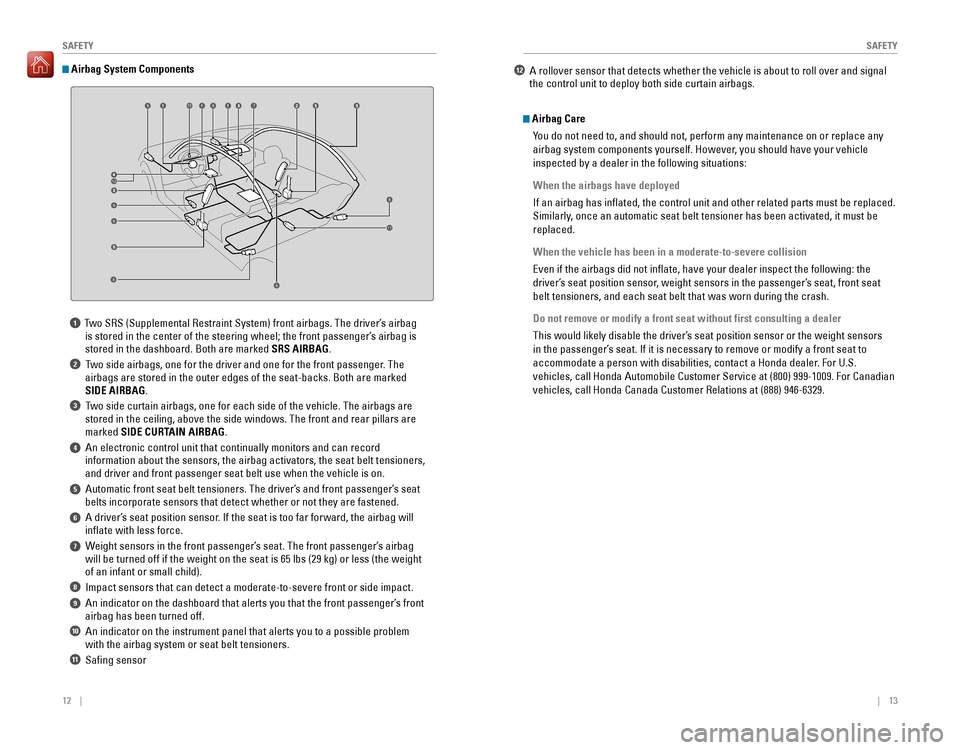
12 || 13
SAFETYSAFETY
1 Two‚ÄāSRS‚Äā(Supplemental‚ÄāRestraint‚ÄāSystem)‚Äāfront‚Äāairbags.‚ÄāThe‚Äādriver‚Äôs‚Äāairbag‚Äā
is‚Äāstored‚Äāin‚Äāthe‚Äācenter‚Äāof‚Äāthe‚Äāsteering‚Äāwheel;‚Äāthe‚Äāfront‚Äāpassenger‚Äôs‚Äāairbag‚Äāis‚Äā
stored‚Äāin‚Äāthe‚Äādashboard.‚ÄāBoth‚Äāare‚Äāmarked‚ÄāSRS AIRBAG.
2‚Äā‚ÄāTwo‚Äāside‚Äāairbags,‚Äāone‚Äāfor‚Äāthe‚Äādriver‚Äāand‚Äāone‚Äāfor‚Äāthe‚Äāfront‚Äāpassenger.‚ÄāThe‚Äā
airbags‚Äāare‚Äāstored‚Äāin‚Äāthe‚Äāouter‚Äāedges‚Äāof‚Äāthe‚Äāseat-backs.‚ÄāBoth‚Äāare‚Äāmarked‚Äā
SIDE AIRBAG.
3‚Äā‚ÄāTwo‚Äāside‚Äācurtain‚Äāairbags,‚Äāone‚Äāfor‚Äāeach‚Äāside‚Äāof‚Äāthe‚Äāvehicle.‚ÄāThe‚Äāairbags‚Äāare‚Äā
stored‚Äāin‚Äāthe‚Äāceiling,‚Äāabove‚Äāthe‚Äāside‚Äāwindows.‚ÄāThe‚Äāfront‚Äāand‚Äārear‚Äāpillars‚Äāare‚Äā
marked SIDE CURTAIN AIRBAG.
4 An electronic control unit that continually monitors and can record
information‚Äāabout‚Äāthe‚Äāsensors,‚Äāthe‚Äāairbag‚Äāactivators,‚Äāthe‚Äāseat‚Äābelt‚Äātensioners,‚Äā
and‚Äādriver‚Äāand‚Äāfront‚Äāpassenger‚Äāseat‚Äābelt‚Äāuse‚Äāwhen‚Äāthe‚Äāvehicle‚Äāis‚Äāon.
5‚Äā‚ÄāAutomatic‚Äāfront‚Äāseat‚Äābelt‚Äātensioners.‚ÄāThe‚Äādriver‚Äôs‚Äāand‚Äāfront‚Äāpassenger‚Äôs‚Äāseat‚Äā
belts‚Äāincorporate‚Äāsensors‚Äāthat‚Äādetect‚Äāwhether‚Äāor‚Äānot‚Äāthey‚Äāare‚Äāfastened.
6‚Äā‚ÄāA‚Äādriver‚Äôs‚Äāseat‚Äāposition‚Äāsensor.‚ÄāIf‚Äāthe‚Äāseat‚Äāis‚Äātoo‚Äāfar‚Äāforward,‚Äāthe‚Äāairbag‚Äāwill‚Äā
inflate with less force.
7‚Äā‚ÄāWeight‚Äāsensors‚Äāin‚Äāthe‚Äāfront‚Äāpassenger‚Äôs‚Äāseat.‚ÄāThe‚Äāfront‚Äāpassenger‚Äôs‚Äāairbag‚Äā
will‚Äābe‚Äāturned‚Äāoff‚Äāif‚Äāthe‚Äāweight‚Äāon‚Äāthe‚Äāseat‚Äāis‚Äā65‚Äālbs‚Äā(29‚Äākg)‚Äāor‚Äāless‚Äā(the‚Äāweight‚Äā
of an infant or small child).
8‚Äā‚ÄāImpact‚Äāsensors‚Äāthat‚Äācan‚Äādetect‚Äāa‚Äāmoderate-to-severe‚Äāfront‚Äāor‚Äāside‚Äāimpact.
9‚Äā‚ÄāAn‚Äāindicator‚Äāon‚Äāthe‚Äādashboard‚Äāthat‚Äāalerts‚Äāyou‚Äāthat‚Äāthe‚Äāfront‚Äāpassenger‚Äôs‚Äāfront‚Äā
airbag‚Äāhas‚Äābeen‚Äāturned‚Äāoff.
10‚Äā‚ÄāAn‚Äāindicator‚Äāon‚Äāthe‚Äāinstrument‚Äāpanel‚Äāthat‚Äāalerts‚Äāyou‚Äāto‚Äāa‚Äāpossible‚Äāproblem‚Äā
with‚Äāthe‚Äāairbag‚Äāsystem‚Äāor‚Äāseat‚Äābelt‚Äātensioners.
11 Safing sensor
Airbag System Components
Airbag Care
You do not need to, and should not, perform any maintenance on or replace\
any
airbag‚Äāsystem‚Äācomponents‚Äāyourself.‚ÄāHowever,‚Äāyou‚Äāshould‚Äāhave‚Äāyour‚Äāvehicle‚Äā
inspected‚Äāby‚Äāa‚Äādealer‚Äāin‚Äāthe‚Äāfollowing‚Äāsituations:
When the airbags have deployed
If‚Äāan‚Äāairbag‚Äāhas‚Äāinflated,‚Äāthe‚Äācontrol‚Äāunit‚Äāand‚Äāother‚Äārelated‚Äāparts‚Äāmust‚Äābe‚Äāreplaced.‚Äā
Similarly,‚Äāonce‚Äāan‚Äāautomatic‚Äāseat‚Äābelt‚Äātensioner‚Äāhas‚Äābeen‚Äāactivated,‚Äāit‚Äāmust‚Äābe‚Äā
replaced.
When the vehicle has been in a moderate-to-severe collision
Even‚Äāif‚Äāthe‚Äāairbags‚Äādid‚Äānot‚Äāinflate,‚Äāhave‚Äāyour‚Äādealer‚Äāinspect‚Äāthe‚Äāfollowing:‚Äāthe‚Äā
driver’s seat position sensor, weight sensors in the passenger’s seat, front seat
belt‚Äātensioners,‚Äāand‚Äāeach‚Äāseat‚Äābelt‚Äāthat‚Äāwas‚Äāworn‚Äāduring‚Äāthe‚Äācrash.
Do not remove or modify a front seat without first consulting a dealer
This‚Äāwould‚Äālikely‚Äādisable‚Äāthe‚Äādriver‚Äôs‚Äāseat‚Äāposition‚Äāsensor‚Äāor‚Äāthe‚Äāweight‚Äāsensors‚Äā
in‚Äāthe‚Äāpassenger‚Äôs‚Äāseat.‚ÄāIf‚Äāit‚Äāis‚Äānecessary‚Äāto‚Äāremove‚Äāor‚Äāmodify‚Äāa‚Äāfront‚Äāseat‚Äāto‚Äā
accommodate‚Äāa‚Äāperson‚Äāwith‚Äādisabilities,‚Äācontact‚Äāa‚ÄāHonda‚Äādealer.‚ÄāFor‚ÄāU.S.‚Äā
vehicles,‚Äācall‚ÄāHonda‚ÄāAutomobile‚ÄāCustomer‚ÄāService‚Äāat‚Äā(800)‚Äā999-1009.‚ÄāFor‚ÄāCanadian‚Äā
vehicles, call Honda Canada Customer relations at (888) 946-6329.
6
7
8
9
8
8
8
8810
11
12
12‚Äā‚ÄāA‚Äārollover‚Äāsensor‚Äāthat‚Äādetects‚Äāwhether‚Äāthe‚Äāvehicle‚Äāis‚Äāabout‚Äāto‚Äāroll‚Äāover‚Äāand‚Äāsignal‚Äā
the‚Äācontrol‚Äāunit‚Äāto‚Äādeploy‚Äāboth‚Äāside‚Äācurtain‚Äāairbags.
Page 14 of 83
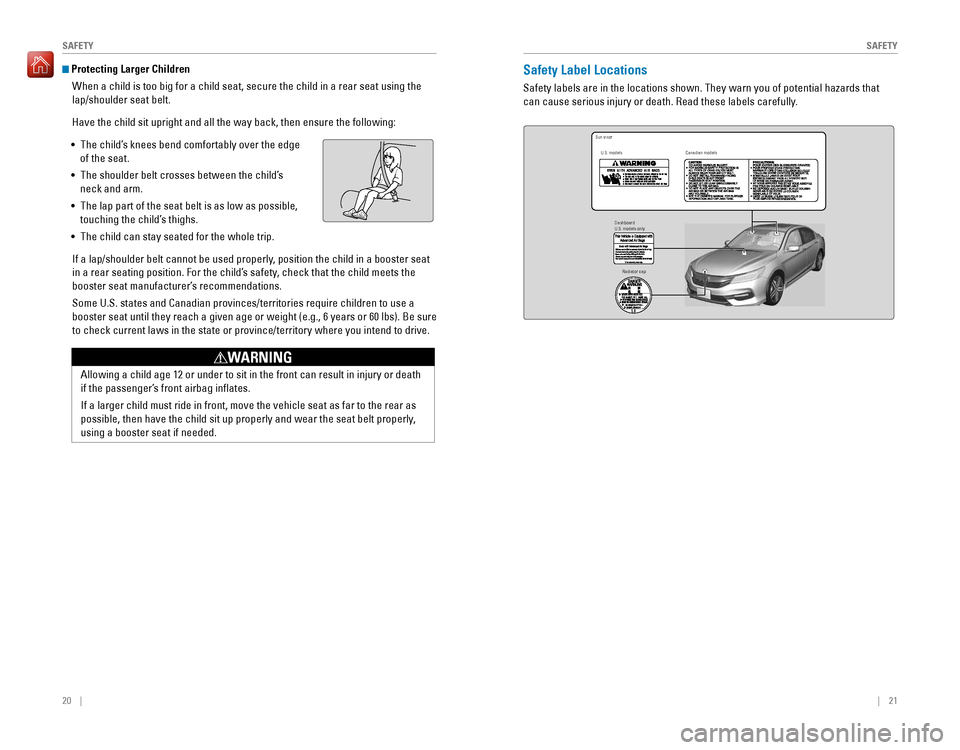
20 || 21
SAFETYSAFETY
Protecting Larger Children
When‚Äāa‚Äāchild‚Äāis‚Äātoo‚Äābig‚Äāfor‚Äāa‚Äāchild‚Äāseat,‚Äāsecure‚Äāthe‚Äāchild‚Äāin‚Äāa‚Äārear‚Äāseat‚Äāusing‚Äāthe‚Äā
lap/shoulder‚Äāseat‚Äābelt.
Have‚Äāthe‚Äāchild‚Äāsit‚Äāupright‚Äāand‚Äāall‚Äāthe‚Äāway‚Äāback,‚Äāthen‚Äāensure‚Äāthe‚Äāfollowing:
‚ÄĘ‚ÄāThe‚Äāchild‚Äôs‚Äāknees‚Äābend‚Äācomfortably‚Äāover‚Äāthe‚Äāedge‚Äā
of the seat.
‚ÄĘ‚Äā
The‚Äāshoulder‚Äābelt‚Äācrosses‚Äābetween‚Äāthe‚Äāchild‚Äôs‚Äā
neck and arm.
‚ÄĘ‚Äā
The‚Äālap‚Äāpart‚Äāof‚Äāthe‚Äāseat‚Äābelt‚Äāis‚Äāas‚Äālow‚Äāas‚Äāpossible,‚Äā
touching the child’s thighs.
‚ÄĘ‚Äā The child can stay seated for the whole trip.
If‚Äāa‚Äālap/shoulder‚Äābelt‚Äācannot‚Äābe‚Äāused‚Äāproperly,‚Äāposition‚Äāthe‚Äāchild‚Äāin‚Äāa‚Äābooster‚Äāseat‚Äā
in a rear seating position. For the child’s safety, check that the child meets the
booster‚Äāseat‚Äāmanufacturer‚Äôs‚Äārecommendations.
Some‚ÄāU.S.‚Äāstates‚Äāand‚ÄāCanadian‚Äāprovinces/territories‚Äārequire‚Äāchildren‚Äāto‚Äāuse‚Äāa‚Äā
booster‚Äāseat‚Äāuntil‚Äāthey‚Äāreach‚Äāa‚Äāgiven‚Äāage‚Äāor‚Äāweight‚Äā(e.g.,‚Äā6‚Äāyears‚Äāor‚Äā60‚Äālbs).‚ÄāBe‚Äāsure‚Äā
to‚Äācheck‚Äācurrent‚Äālaws‚Äāin‚Äāthe‚Äāstate‚Äāor‚Äāprovince/territory‚Äāwhere‚Äāyou‚Äāintend‚Äāto‚Äādrive.
Safety Label Locations
Safety‚Äālabels‚Äāare‚Äāin‚Äāthe‚Äālocations‚Äāshown.‚ÄāThey‚Äāwarn‚Äāyou‚Äāof‚Äāpotential‚Äāhazards‚Äāthat‚Äā
can‚Äācause‚Äāserious‚Äāinjury‚Äāor‚Äādeath.‚ÄāRead‚Äāthese‚Äālabels‚Äācarefully.
Sun visor
U.S. models Canadian models
Radiator cap
U.S. models only
Dashboard
Allowing a child age 12 or under to sit in the front can result in injur\
y or death
if‚Äāthe‚Äāpassenger‚Äôs‚Äāfront‚Äāairbag‚Äāinflates.
If‚Äāa‚Äālarger‚Äāchild‚Äāmust‚Äāride‚Äāin‚Äāfront,‚Äāmove‚Äāthe‚Äāvehicle‚Äāseat‚Äāas‚Äāfar‚Äāto‚Äāthe‚Äārear‚Äāas‚Äā
possible,‚Äāthen‚Äāhave‚Äāthe‚Äāchild‚Äāsit‚Äāup‚Äāproperly‚Äāand‚Äāwear‚Äāthe‚Äāseat‚Äābelt‚Äāproperly,‚Äā
using‚Äāa‚Äābooster‚Äāseat‚Äāif‚Äāneeded.
WARNING
Page 23 of 83
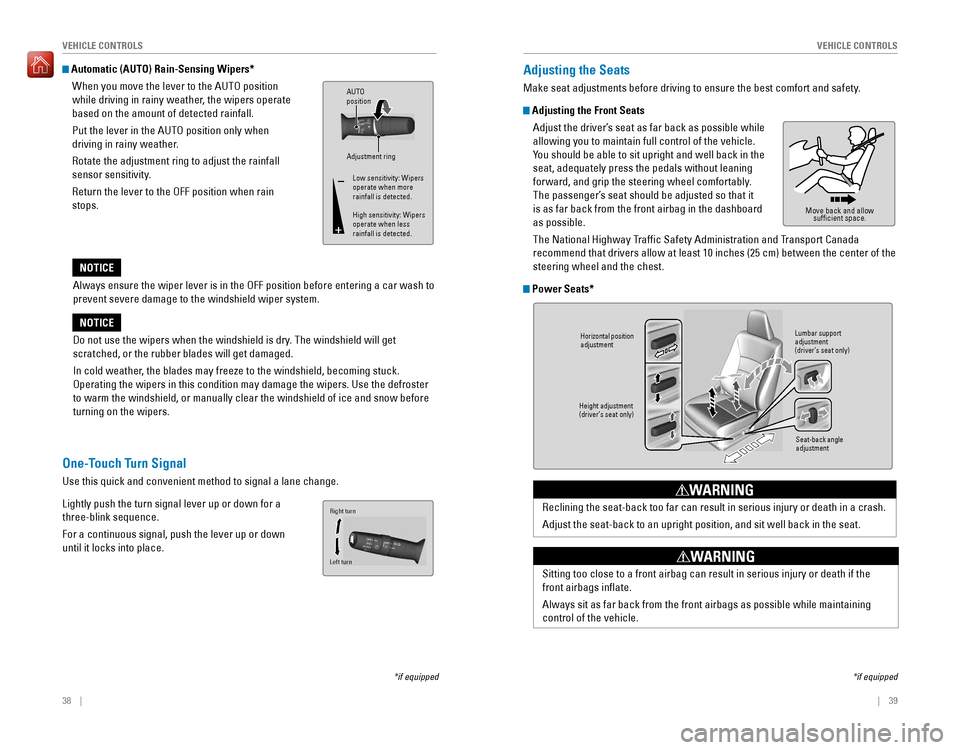
38 || 39
VEHICLE CONTROLSVEHICLE CONTROLS
Always‚Äāensure‚Äāthe‚Äāwiper‚Äālever‚Äāis‚Äāin‚Äāthe‚ÄāOFF‚Äāposition‚Äābefore‚Äāentering‚Äāa‚Äācar‚Äāwash‚Äāto‚Äā
prevent severe damage to the windshield wiper system.
NOTICE
Do not use the wipers when the windshield is dry. The windshield will get
scratched,‚Äāor‚Äāthe‚Äārubber‚Äāblades‚Äāwill‚Äāget‚Äādamaged.
In‚Äācold‚Äāweather,‚Äāthe‚Äāblades‚Äāmay‚Äāfreeze‚Äāto‚Äāthe‚Äāwindshield,‚Äābecoming‚Äāstuck.‚Äā
operating the wipers in this condition may damage the wipers. Use the def\
roster
to‚Äāwarm‚Äāthe‚Äāwindshield,‚Äāor‚Äāmanually‚Äāclear‚Äāthe‚Äāwindshield‚Äāof‚Äāice‚Äāand‚Äāsnow‚Äābefore‚Äā
turning on the wipers.
NOTICE
Automatic (AUTO) Rain-Sensing Wipers*
When‚Äāyou‚Äāmove‚Äāthe‚Äālever‚Äāto‚Äāthe‚ÄāAUTO‚Äāposition‚Äā
while driving in rainy weather, the wipers operate
based‚Äāon‚Äāthe‚Äāamount‚Äāof‚Äādetected‚Äārainfall.
Put the lever in the AUTo position only when
driving in rainy weather.
rotate the adjustment ring to adjust the rainfall
sensor sensitivity.
return the lever to the oFF position when rain
stops.
Adjustment ring
AUTO
position
Low sensitivity: Wipers
operate when more
rainfall is detected.
High sensitivity: Wipers
operate when less
rainfall is detected.
*if‚Äāequipped
One-Touch Turn Signal
Use‚Äāthis‚Äāquick‚Äāand‚Äāconvenient‚Äāmethod‚Äāto‚Äāsignal‚Äāa‚Äālane‚Äāchange.
Lightly push the turn signal lever up or down for a
three-blink‚Äāsequence.
For a continuous signal, push the lever up or down
until it locks into place.
Right turn
Left turn
Adjusting the Seats
Make‚Äāseat‚Äāadjustments‚Äābefore‚Äādriving‚Äāto‚Äāensure‚Äāthe‚Äābest‚Äācomfort‚Äāand‚Äāsafety.
Adjusting the Front Seats
Adjust‚Äāthe‚Äādriver‚Äôs‚Äāseat‚Äāas‚Äāfar‚Äāback‚Äāas‚Äāpossible‚Äāwhile‚Äā
allowing you to maintain full control of the vehicle.
You‚Äāshould‚Äābe‚Äāable‚Äāto‚Äāsit‚Äāupright‚Äāand‚Äāwell‚Äāback‚Äāin‚Äāthe‚Äā
seat,‚Äāadequately‚Äāpress‚Äāthe‚Äāpedals‚Äāwithout‚Äāleaning‚Äā
forward,‚Äāand‚Äāgrip‚Äāthe‚Äāsteering‚Äāwheel‚Äācomfortably.‚Äā
The‚Äāpassenger‚Äôs‚Äāseat‚Äāshould‚Äābe‚Äāadjusted‚Äāso‚Äāthat‚Äāit‚Äā
is‚Äāas‚Äāfar‚Äāback‚Äāfrom‚Äāthe‚Äāfront‚Äāairbag‚Äāin‚Äāthe‚Äādashboard‚Äā
as‚Äāpossible.
The National Highway Traffic Safety Administration and Transport Canada
recommend‚Äāthat‚Äādrivers‚Äāallow‚Äāat‚Äāleast‚Äā10‚Äāinches‚Äā(25‚Äācm)‚Äābetween‚Äāthe‚Äācenter‚Äāof‚Äāthe‚Äā
steering wheel and the chest.
Power Seats*
Move‚Äāback‚Äāand‚Äāallow‚Äāsufficient space.
*if‚Äāequipped
Horizontal position
adjustment
Height adjustment
(driver’s seat only) Seat-back angle
adjustment
Lumbar support
adjustment
(driver’s seat only)
Reclining‚Äāthe‚Äāseat-back‚Äātoo‚Äāfar‚Äācan‚Äāresult‚Äāin‚Äāserious‚Äāinjury‚Äāor‚Äādeath‚Äāin‚Äāa‚Äācrash.
Adjust‚Äāthe‚Äāseat-back‚Äāto‚Äāan‚Äāupright‚Äāposition,‚Äāand‚Äāsit‚Äāwell‚Äāback‚Äāin‚Äāthe‚Äāseat.
WARNING
Sitting‚Äātoo‚Äāclose‚Äāto‚Äāa‚Äāfront‚Äāairbag‚Äācan‚Äāresult‚Äāin‚Äāserious‚Äāinjury‚Äāor‚Äādeath‚Äāif‚Äāthe‚Äā
front‚Äāairbags‚Äāinflate.
Always‚Äāsit‚Äāas‚Äāfar‚Äāback‚Äāfrom‚Äāthe‚Äāfront‚Äāairbags‚Äāas‚Äāpossible‚Äāwhile‚Äāmaintaining‚Äā
control of the vehicle.
WARNING
Page 27 of 83
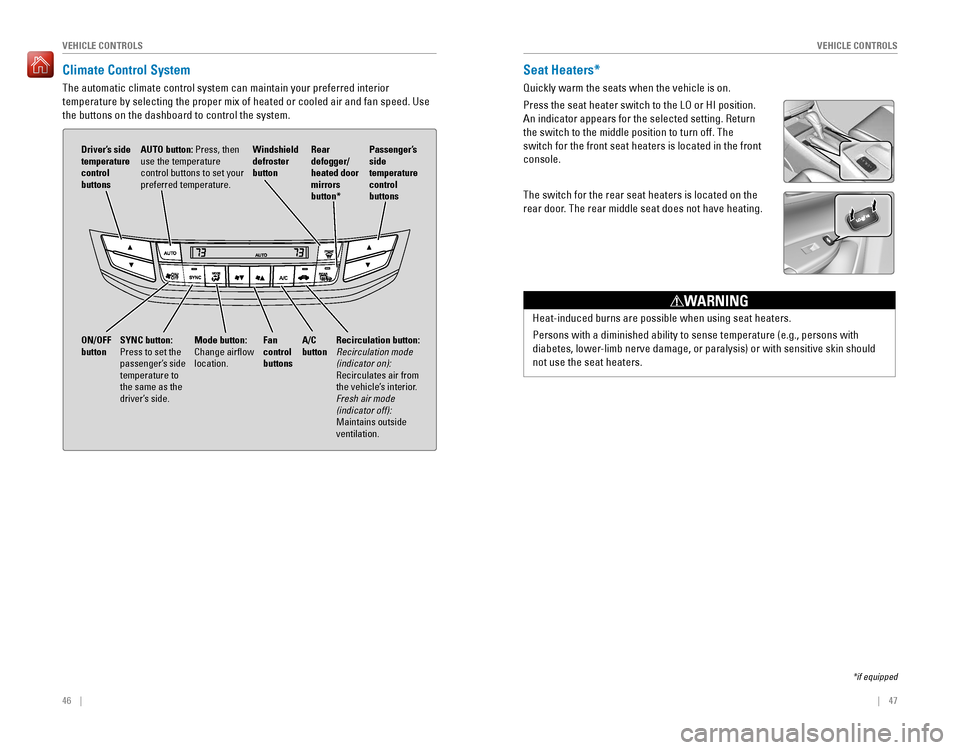
46 || 47
VEHICLE CONTROLSVEHICLE CONTROLS
Climate Control System
The automatic climate control system can maintain your preferred interio\
r
temperature‚Äāby‚Äāselecting‚Äāthe‚Äāproper‚Äāmix‚Äāof‚Äāheated‚Äāor‚Äācooled‚Äāair‚Äāand‚Äāfan‚Äāspeed.‚ÄāUse‚Äā
the‚Äābuttons‚Äāon‚Äāthe‚Äādashboard‚Äāto‚Äācontrol‚Äāthe‚Äāsystem.
AUTO button: Press, then
use the temperature
control‚Äābuttons‚Äāto‚Äāset‚Äāyour‚Äāpreferred temperature.
Driver’s side
temperature
control
buttons
A/C
button
Fan
control
buttons Recirculation button:
Recirculation‚Äāmode‚Äā(indicator‚Äāon): recirculates air from the vehicle‚Äôs interior. Fresh‚Äāair‚Äāmode‚Äā(indicator‚Äāoff):
Maintains outside
ventilation.
Rear
defogger/
heated door
mirrors
button*
Windshield
defroster
button
ON/OFF
button
Mode button:
Change airflow
location.
Passenger’s
side
temperature
control
buttons
SYNC button:
Press to set the
passenger’s side
temperature to
the same as the
driver’s side.
*if‚Äāequipped
Seat Heaters*
Quickly warm the seats when the vehicle is on.
Press‚Äāthe‚Äāseat‚Äāheater‚Äāswitch‚Äāto‚Äāthe‚ÄāLO‚Äāor‚ÄāHI‚Äāposition.‚Äā
An indicator appears for the selected setting. return
the switch to the middle position to turn off. The
switch for the front seat heaters is located in the front
console.
The switch for the rear seat heaters is located on the
rear door. The rear middle seat does not have heating.
Heat-induced‚Äāburns‚Äāare‚Äāpossible‚Äāwhen‚Äāusing‚Äāseat‚Äāheaters.
Persons‚Äāwith‚Äāa‚Äādiminished‚Äāability‚Äāto‚Äāsense‚Äātemperature‚Äā(e.g.,‚Äāpersons‚Äāwith‚Äā
diabetes,‚Äālower-limb‚Äānerve‚Äādamage,‚Äāor‚Äāparalysis)‚Äāor‚Äāwith‚Äāsensitive‚Äāskin‚Äāshould‚Äā
not use the seat heaters.
WARNING
Page 31 of 83
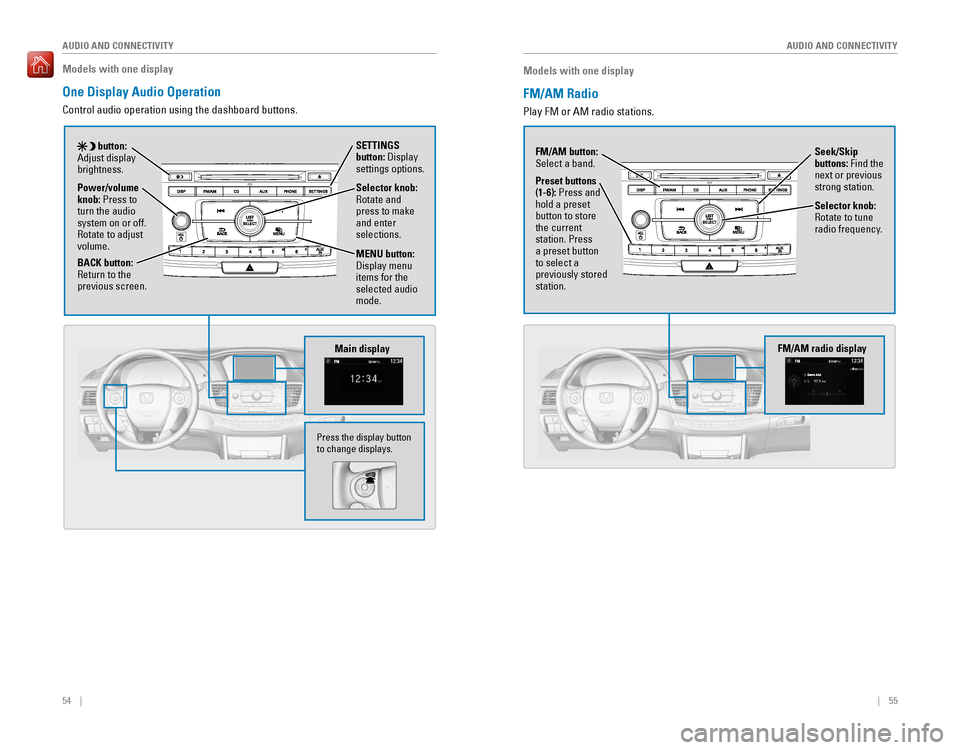
54 || 55
AUDIO AND CONNECTIVITY
AUDIO AND CONNECTIVITY
Models with one display
One Display Audio Operation
Control‚Äāaudio‚Äāoperation‚Äāusing‚Äāthe‚Äādashboard‚Äābuttons.
Main display
Selector knob: rotate and press to make
and enter
selections.
MENU button:
Display menu
items for the
selected audio
mode.
Power/volume
knob:‚ÄāPress to
turn the audio
system on or off.
rotate to adjust volume.
button: Adjust display
brightness. SETTINGS
button: Display
settings options.
BACK button:
return to the previous screen.
Press‚Äāthe‚Äādisplay‚Äābutton‚Äāto change displays.
Models with one display
FM/AM Radio
Play FM or AM radio stations.
Seek/Skip
buttons: Find the
next or previous
strong station.
Selector knob:
rotate to tune radio‚Äāfrequency.
FM/AM button:‚ÄāSelect‚Äāa‚Äāband.
Preset buttons
(1-6): Press and
hold a preset
button‚Äāto‚Äāstore‚Äāthe current
station. Press
a‚Äāpreset‚Äābutton‚Äāto select a
previously stored
station.
FM/AM radio display
Page 67 of 83
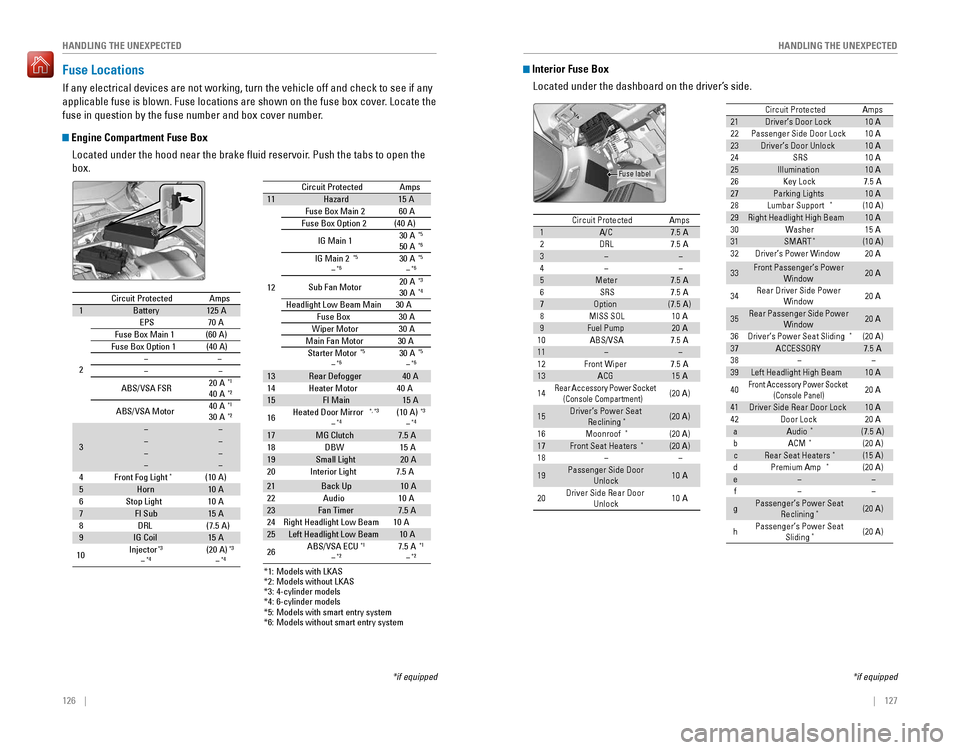
126 || 127
HANDLING THE UNEXPECTED
HANDLING THE UNEXPECTED
Fuse Locations
If‚Äāany‚Äāelectrical‚Äādevices‚Äāare‚Äānot‚Äāworking,‚Äāturn‚Äāthe‚Äāvehicle‚Äāoff‚Äāand‚Äācheck‚Äāto‚Äāsee‚Äāif‚Äāany‚Äā
applicable‚Äāfuse‚Äāis‚Äāblown.‚ÄāFuse‚Äālocations‚Äāare‚Äāshown‚Äāon‚Äāthe‚Äāfuse‚Äābox‚Äācover.‚ÄāLocate‚Äāthe‚Äā
fuse‚Äāin‚Äāquestion‚Äāby‚Äāthe‚Äāfuse‚Äānumber‚Äāand‚Äābox‚Äācover‚Äānumber.‚Äā
Engine Compartment Fuse Box
Located‚Äāunder‚Äāthe‚Äāhood‚Äānear‚Äāthe‚Äābrake‚Äāfluid‚Äāreservoir.‚ÄāPush‚Äāthe‚Äātabs‚Äāto‚Äāopen‚Äāthe‚Äā
box.
*if‚Äāequipped*1 : Models with LKAS
*2 : Models without LKAS
*3 : 4-cylinder models
*4 : 6-cylinder models
Circuit ProtectedAmps1Battery125A
2
EPS70 A
Fuse Box Main 1(60A)
Fuse Box Option 1(40A )����
ABS/VSA FSR 20
A*1
40A*2
ABS/VSA Motor 40
A*1
30A*2
3
��������
4F ront Fog Ligh t*(10A )5Horn10A
6S top Light10A7FI Sub15A
8D RL(7.5 A)
9IG Coil15A
10 Injector*3
�*4(2
0A )*3
�*4
*5: M odels with smart entry syste m
*6: Models without smart entry system Circuit Protected
Amps
11 Hazard 15A
12 Fuse Box Main
260A
Fuse Box Option 2(40 A)
IG Main 1 30
A
*5
50A*6
IG Main 2*5
�*630A*5
�*6
Sub Fan Moto r20
A*3
30A*4
Headlight Low Beam Main 30 A
Fuse Box3 0A
Wiper Moto r3 0A
Main Fan Motor 30A
Starter Motor
*5
�*630 A*5
�*6
13 Rear Defogger 40A
14 Heater Moto r40A
15 FI Main 15A
16 Heated Door Mirror
*, *3
�*4(10 A)*3
�*4
17
MG Clutch 7.5 A
18 DBW1 5A
19 Small Light 20A
20 Interior Light 7.5A
21 Back Up 10A
22 Audio1 0A
23 Fan Timer 7.5 A
24 Right Headlight Low Beam 10A
25 Left Headlight Low Beam 10A
26 ABS/VSA EC
U
*1
�*27.5 A*1
�*2
*1: Models with LKAS
*2 : Models without LKAS
*3 : 4-cylinder models
*4 : 6-cylinder models
Circuit Protected Amps
1 Battery 125A
2 EPS
70A
Fuse Box Main 1(60A)
Fuse Box Option 1(40A )
��
� �
ABS/VSA FSR 20
A
*1
40A*2
ABS/VSA Motor 40
A*1
30A*2
3 �
�
� �
� �
� �
4F ront Fog Ligh t
*(10A )
5 Horn 10A
6S top Light1 0A
7 FI Sub 15A
8D RL(7.5 A)
9 IG Coil 15A
10 Injector
*3
�*4(2
0A )*3
�*4
*5: M odels with smart entry syste m
*6: Models without smart entry system
Circuit ProtectedAmps11Hazard15 A
12 Fuse Box Main 260A
Fuse Box Option 2(40 A)
IG Main 1 30
A
*5
50A*6
IG Main 2*5
�*630A*5
�*6
Sub Fan Moto r20
A*3
30A*4
Headlight Low Beam Main 30 A
Fuse Box30A
Wiper Motor30A
Main Fan Motor 30A
Starter Motor
*5
�*630 A*5
�*6
13Rear Defogger40A
14 Heater Motor40A15FI Main15 A
16 Heated Door Mirror*, *3
�*4(10 A)*3
�*4
17MG Clutch7.5 A
18 DBW15A19Small Light20A
20 Interior Light 7.5A
21Back Up10 A
22 Audio10A23Fan Timer7.5 A
24 Right Headlight Low Beam 10A
25Left Headlight Low Beam10A
26 ABS/VSA EC
U*1
�*27.5 A*1
�*2
Interior Fuse Box
Located‚Äāunder‚Äāthe‚Äādashboard‚Äāon‚Äāthe‚Äādriver‚Äôs‚Äāside.
*if‚Äāequipped
Circuit ProtectedAmps1A/C7.5 A2DRL7.5 A3��4��5Meter7.5 A6SRS7.5 A7Option(7.5A )8MISS SOL10A9Fuel Pump20A10ABS/VSA7.5A11��12Front Wipe r7.5A13ACG15 A
14Rear Accessory Power Socket
(Console Compartment )(20A )
15Driver’s Power Seat
Reclining*(20A )
16Moonroof*(20A )17Front Seat Heaters*(20A )18��
19Passenger Side Door
Unlock10A
20 Driver Side Rear Door
Unlock 10
A
21 Driver’s Door Lock 10A
22 Passenger Side Door Lock 10A
23 Driver’s Door Unlock 10A
24 SRS 10A
25 Illumination 10A
26 Key Lock 7.5A
27 Parking Lights 10A
28 Lumbar Support
*(10A )
29 Right Headlight High Beam 10A
30 Washer 15A
31 SMART
*(10A )
32 Driver’s Power Window 20A
33 Front Passenger’s Power
Window 20
A
34 Rear Driver Side Power
Window 20
A
35 Rear Passenger Side Power
Window 20
A
36 Driver’s Power Seat Sliding
*(20 A)
37 ACCESSORY 7.5A
38 � �
39 Left Headlight High Beam 10A
40
Front Accessory Powe r Socket
(Con sole Panel)20A
41 Driver Side Rear Door Lock 10A
42 Door Lock 20A
a Audio
*(7.5 A)
b ACM*(20 A)
c Rear Seat Heaters*(15 A)
d Premium Amp*(20 A)
e � �
f � �
g Passenger’s Power Seat
Reclining
*(20 A)
h Passenger’s Power Seat
Sliding
*(20 A)
Circuit Protecte dAmps
Fuse label
Circuit Protected Amps
1 A/C 7.5 A
2 DRL 7.5 A
3 � �
4 � �
5 Meter 7.5 A
6 SRS 7.5 A
7 Option (7.5A)
8 MISS SOL 10A
9 Fuel Pump 20A
10 ABS/VSA 7.5A
11 � �
12 Front Wiper 7.5A
13 ACG 15A
14
Rear Accessory Power Socket
(Console Compartment )(20A )
15 Driver’s Power Seat
Reclining
*(20A )
16 Moonroof
*(2 0A )
17 Front Seat Heaters*(20A )
18 � �
19 Passenger Side Door
Unlock 10
A
20 Driver Side Rear Door
Unlock 10
A
21Driver’s Door Lock10A22Passenger Side Door Lock10A23Driver’s Door Unlock10A24SRS10A25Illuminatio n10A26Key Lock7.5A27Parking Lights10 A28Lumbar Support*(10A )29Right Headlight High Beam10A30Washe r15A31SMART*(10A )32Driver’s Power Window20A
33Front Passenger’s Power
Window20A
34Rear Driver Side Power
Window20A
35Rear Passenger Side Power
Window20A
36Driver‚Äôs Power Seat Sliding*(20 A)37ACCESSORY7.5A38��39Left Headlight High Beam10A
40Front Accessory Powe r Socket
(Con sole Panel)20A
41Driver Side Rear Door Lock10A42Door Loc k20AaAudio*(7.5 A)bACM*(20 A)cRear Seat Heaters*(15 A)dPremium Amp*(20 A)e��f��
gPassenger’s Power Seat
Reclining*(20 A)
hPassenger’s Power Seat Sliding*(20 A)
Circuit Protecte dAmps